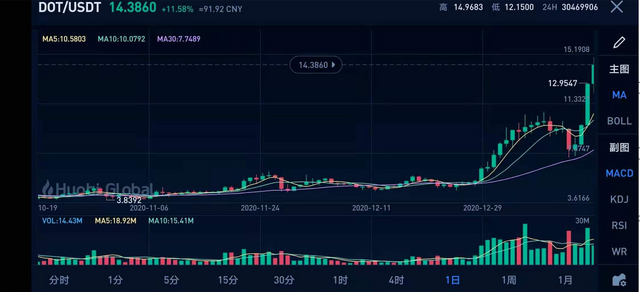DOT has been on the rise in recent days, so let's learn a little about DOT
Before we do that let's understand what is Polkadot?
Polkadot is a cryptocurrency project that helps to realize the decentralized future of the Internet (Web 3.0.) Polkadot enables interoperability with other blockchains outside of cryptocurrencies and allows the creation of smart contracts and new blockchains (and tokens) that make it possible for blockchains to exchange information.
You can see the latest DOT trend on the trading platform in the chart below

What is DOT coin?
DOT is a cryptographic digital currency on the Polkadot network, used for governance, pledging and binding within the Polkadot network. Anyone holding a DOT can vote for proposed changes to Polkadot. DOT serves three key functions in Polkadot: for the governance of the network, for the operation of the network, and for being tied and thus connecting parallel chains to Polkadot.
DOT for network management
The first function of DOT is the governance of the licensee control platform. A number of functions are included under the governance mechanism, including determining network costs, adding or removing parallel chains, and some special events, such as upgrading and repairing the Polkadot platform.
Polkadot allows any DOT holder to participate in governance. For more information on how holders can participate in governance, and their rights and responsibilities.
DOT for Consensus
The DOT will be used to facilitate the consensus mechanism that supports Polkadot. In order for the platform to function properly and allow for efficient transactions between parallel chains, Polkadot will rely on DOT holders to play an active role. Participants will perform these functions by placing their DOTs at risk (through pledges). Pledging DOT acts as a disincentive for malicious participants, who will be penalized by the network by slashing their DOT. The DOT required to participate in the network will vary depending on the activity being performed, the length of time the DOT is pledged, and the total number of DOTs pledged.
DOTs for Binding
DOTs can be bound for a period of time to add a new parallel chain to the network. During the binding period the DOT will be locked and when the binding period passes and the parallel chain is deleted, the DOT will be released back to the bound account.
DOT Potential
Polkadot has a lot of advantages compared to Ether. Although both are extensions of the fragmentation technology, Polkadot still shows different development directions, such as more optimized upgrade method (upgrade without hard fork), fairer governance (on-chain governance), more decentralized consensus mechanism (NPOS), and more unique architecture (parallel chain), which are different from Ether, but it doesn't mean Ether is bad, just that Polkadot seems to walk better by stepping on the shoulders of giants.